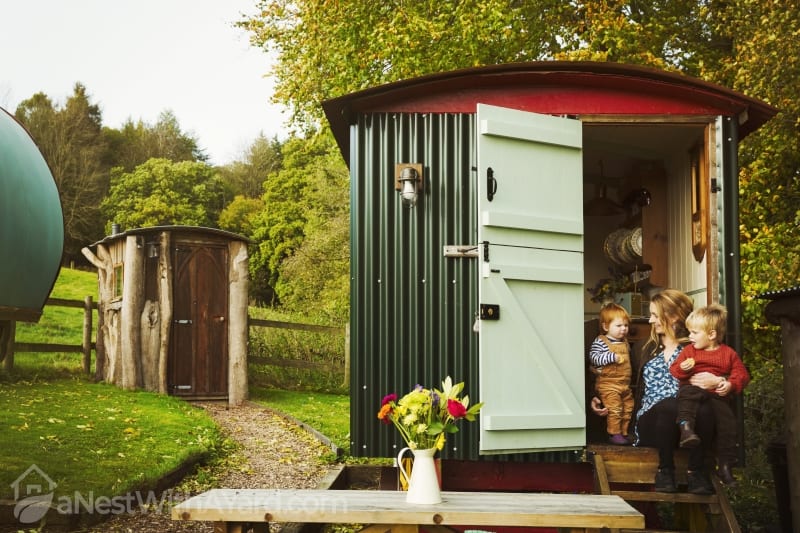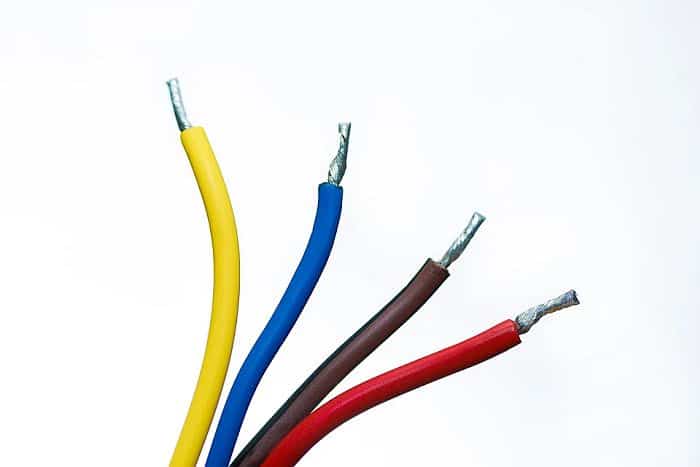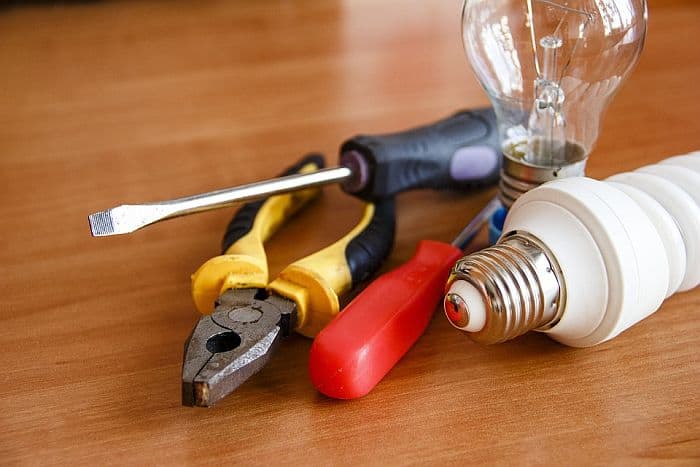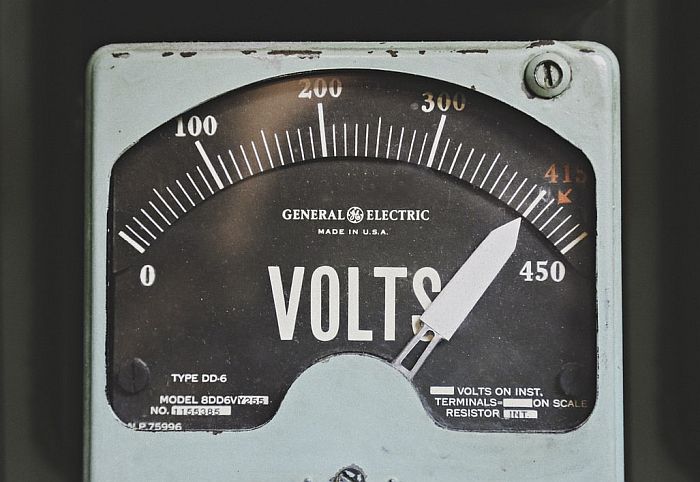The cost to run electricity to a shed depends on who is doing the work. Running power to the shed will cost you 100$ to 600$ if you do it. A licensed electrician will charge you 1,000$ to 4,000$ depending on how much power you want and how far your shed is from the house.
Does your shed have everything but a power source? Looking to run electricity to it?
More and more people are deciding to turn their modest sheds into small workshops. Why not? Having good lighting and electrical outlets in your shed will let you use it for more than just storage and you will immediately boost your curb appeal.
Of course, running electricity to a shed isn’t free. There is the cost of conduct, wiring, materials, tools, and labor you have to account for.
Luckily, you have stumbled upon the right place. Keep on reading! I will help you estimate the cost to run electric to shed!
Looking For Help From a Professional Company?
If you’re looking for an electrician to help you with running electricity to your shed, you can get a free quote from top local contractors here:
Cost To Run Electric To Shed
Analysis

The cost to run electricity to a shed depends on several factors. The biggest determiner of the final price is whether you will be doing the work or hiring a licensed electrician.
If you plan on hiring an electrician, you can expect to spend 1,000$ to 4,000$ in total. Running electricity to a shed will cost you way less if you take on the job, anywhere from 100$ to 600$. The price depends on how far your shed is from the house and how much power you would like to supply to it.
As you may have noticed, there is a huge range of given price ranges here, and paying 1,000$ sure isn’t the same as 4,000$. So, what’s the deal?
As I have mentioned, many different factors determine the price of the project. I will discuss all the variables in the sections to come. Let’s dive in!
What Affects The Cost Of Running Electricity To A Shed?
Distance From House To The Shed
One of the major factors that will affect the installation cost is the distance between your shed and your house. Remember, you are running electricity from your house electricity to your shed.
The more remote your shed is, the more expensive your project will be. That is because you will have to buy more conduit and longer cables. Conduit and wiring are two of the main supplies you will need:
Conduit
An electrical conduit is a durable tubing or enclosure used to protect electrical wiring from damage. Conduit can be made of metal or plastic and can be rigid or flexible. There are seven different types of conduit, but these two are most commonly used outdoors:
- Rigid Metal Conduit (RMC)
Image credit: Flickr.com RMC provides proper protection and structural support to electrical cables and it is available in 10 and 20 ft lengths. Every tube has metal threads that can be connected to reach the distance from your shed to the house.Here are the average prices for RMC you can use to calculate the total cost of conduit:
- ½ inch size: $0.77 per foot
- ¾ inch size: $1.16 per foot
- 1-inch size: $1.60 per foot
People love to use RMC in their projects because it only needs to be buried 6-inches below the surface, unlike rigid PVC. This means you won’t have to dig a very deep trench.Digging a deep trench isn’t easy. You will save on hours of work, especially if you have rocky soil with lots of tree roots. This will instantly show on the bill issued by a hired electrician.
- Rigid Polyvinyl Chloride (Rigid PVC)
Image credit: Flickr.com Rigid PVC is plastic tubing similar to that used in plumbing. The tubing is glued together with the help of plastic fittings to get the required length. PVC conduit is watertight and therefore suited for burial in the ground.Here are the average prices for rigid PVC piping you can use to estimate the cost of conduit:
- ½ inch size: $0.94 per foot
- ¾ inch size: $1.18 per foot
- 1-inch size: $1.62 per foot
You can see that the price of rigid PVC is comparable to the price of RMC. But unlike RMC, PVC conduit has to be buried 18-inches below the surface of the ground to meet The National Electrical Code (NEC).Rigid PVC is lighter than RMC and is easier to cut to the size. Digging a few inches deeper into the ground pays off because you won’t spend so much time cutting the plastic as you would metal. You also won’t have to file down rough metal edges that can tear insulation of the cable when pulled through.
In case your trench is not 18 inches deep across the whole length, you can pour concrete over the conduit in shallow areas, as shown in the video below.
Wires And Cables

The price of the electrical wire depends on the type and the length. You will need wires of different diameters to finish your project.
The size of the electrical cables is indicated in the gauge system. They are inversely related. The bigger the wire is, the smaller gauge it has. Wires with smaller gauges are bigger, can pass more electricity, and are therefore more expensive.
You will need a 6-gauge cable to run power to the shed and at least a 12-gauge cable to install light fixtures and hook up small electric tools. Let’s take a look at the table below:
| Cable Size | Amperage You Get | Approx. Price Per Foot* |
| 12-gauge | 20 amps | from $0.52 to $0.80 |
| 10-gauge | 30 amps | from $1.00 to $2.00 |
| 8-gauge | 40 amps | from $1.80 to $3.90 |
| 6-gauge | 55 amps | from $3.50 to $5.90 |
*These are just approximate price ranges. You may find electrical wires and cables for cheaper, depending on the brand you buy.
Pro Tip: If your shed is more than 80 feet away from your house, increase the gauge size to make sure enough electricity can pass through it. The longer the wire, the more voltage you can lose through heat. By increasing the gauge size, you will increase amperage capacity and counteract voltage drop.
Materials And Supplies

It goes without saying that running electricity to your new man cave shed requires a lot of materials and supplies. Besides conduit and electrical wiring, you will also need some of the supplies listed below. You can check their latest prices by clicking on them:
- LB fittings
- Wire connectors
- Electrical tape
- Duct seal
- Wall switches
- Wall chargers
- Electrical boxes
- Light fixtures
The more light fixtures, switches, and outlets you decide to install, the more costly your project will be. You will need more supplies, more wiring, and more money.
Tools
You will need several powered and hand tools to cut the conduit, drill the holes, and dig a trench. These are some of the tools you may need to complete the job:
- Cordless drill/driver
- Drill bit set
- Hacksaw
- Screwdrivers
- Pliers
- Spade
- Pipe wrench
- Wire stripper
- Torpedo level
- Tape measure
- Fish tape
Most of us already have a tool or two in storage somewhere. Check which tools you already have and go from there and only buy those you need. Slowly but surely, you will build your collection of tools and have everything on hand when you’re doing the next big home improvement project.
The tools listed above are the essentials of every handyman. But, you may end up needing more expensive equipment, like a trencher. Luckily, you don’t have to buy one. You can simply rent it locally to dig a channel for your underground cable. Renting an 18-inch trencher at Home Depot for 4 hours will cost you around $62.00.
How Much Power You Need

The amount of electrical power you want to supply to your shed can greatly impact the total cost. This will affect you only if you intend on using your shed as a workshop, where you will be charging and powering multiple 220V tools.
To get more electricity to your shed, you will have to buy bigger cables, which are more expensive, as seen in the table above.
But that is not all, you may have to upgrade your main circuit breaker box or update the electrical service of your home if it can’t handle the exertion.
If you are living in an older house with a 60 amp service, you will have to update it. Having a 100 amp service is the bare minimum you will need to run multiple modern electric appliances. Even this may not be enough if you have big plans in mind for your shed.
Updating an electric service is quite costly. Let’s take a look:
- Upgrading to 100 amp service costs $850 to $1,600.
- Upgrading to 200 amp service costs $1,300 to $2,500.
- Upgrading to 400 amp service costs $2,000 to $4,000.
Note: The price doesn’t include the replacement of circuit wiring or installing new ones.
Cost Of Labor

There is not much to talk about if you will be doing the work for yourself. Hopefully, you can get a helping hand from a family member or a neighbor who has some experience with electrical work.
If you intend on hiring a licensed electrician, get a bid from at least a couple of them to see which one is the most affordable.
Don’t let the price be the only determiner when choosing an electrical company. Look at their reputation and experience in the field, as well. Sometimes it is better to pay a little bit more for quality than having to deal with repairments later on.
I advise you to hire an electrician if you don’t have any knowledge about electrical work. A qualified handyman will do the job right and faster.
Licensed electricians typically charge a flat service fee for making the visit. This fee usually ranges from $50 to $100 per visit. They charge an hourly rate for the labor once hired that costs from $40 to $120 per hour, depending on the skill level and area where you live. Running electricity to a shed is a 1 to 2-day job.
FAQ
Can I Run Electricity To My Shed?
You can run electricity to your shed if you follow the rules and regulations of The National Electric Code. Connect the shed to the existing circuit from your house. Only make sure the electric service of your home can handle the new addition.
What Size Cable Do I Need To Run Power To My Shed?
What size cable you need to run power to your shed depends on the number of tools you will be powering. A 6-gauge electric cable gets you 55 amps. This is typically enough to give your shed proper lighting and to power bigger tools and appliances.
Safety Over Savings
Running electricity to a shed is a whole lot cheaper if you do it yourself. The cost to run electric to shed is 3 to 4 times lower. You will only have to pay for tools, conduit, wires, wall switches, electrical boxes, and other needed supplies.
But don’t let the cost of running electricity to the shed cost you your life! Always practice safety, and don’t hesitate to hire a licensed electrician if ever in doubt.
Do you agree? Let me know in the comments below, and feel free to ask any questions. I would love to answer them for you!



